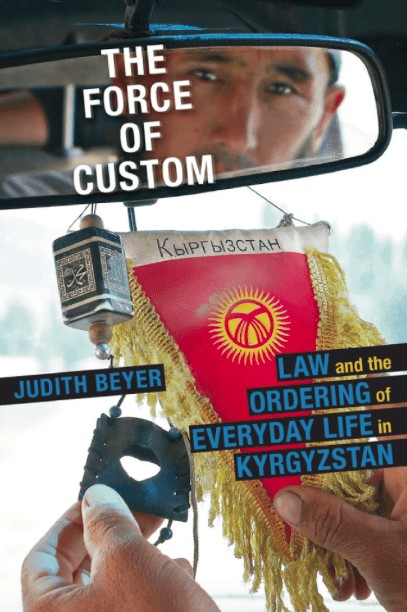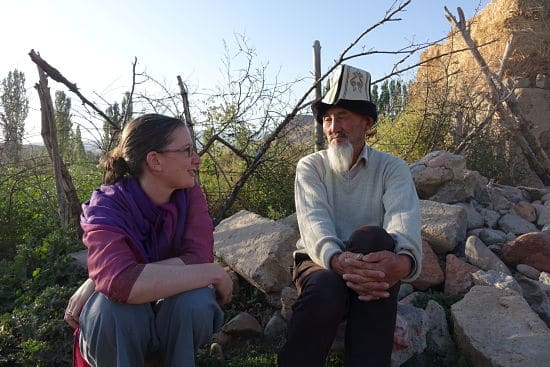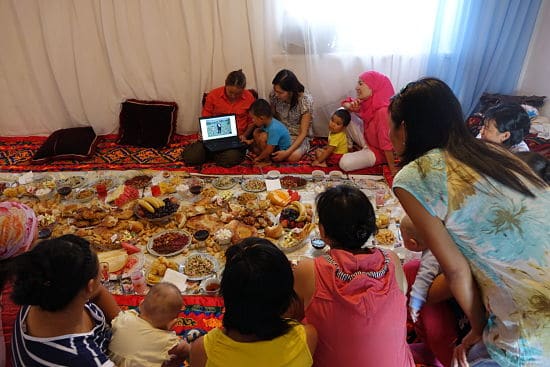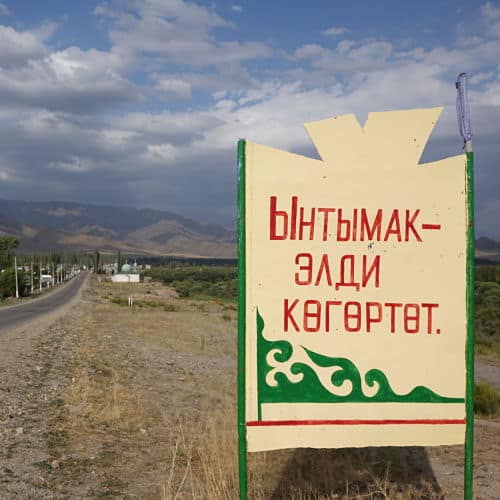The Force of Custom presents a strongly grounded ethnographic argument for the rethinking of ‘customary law’ as a category in the anthropology of law. How does an understanding of tradition and harmony undergird a large historic village community in Talas, Kyrgyzstan? In the realm of the legal, how do local understandings of ‘custom’ and a ‘court of elders’ function together with other codes of law and moral behavior, such as those emanating from either religious or government leadership? What do the elders of Central Asia have to teach us about the lived epistemologies of law and history?
In The Force of Custom, we are presented with two strong and interrelated arguments that resonate throughout the ethnography and exposition of different chapters: first, that in Talas, Kyrgyzstan, the categories of ‘tradition’ (salt) and harmony (yntymak) are major metaphors and lifeways for the ordering of everyday life, and second, taken in historical perspective, ‘legal pluralism’ means that different categories of law and order are not fully separated ex facto, but rather created and realized in heavily overlapping ways (state, religion, custom). In this ethnography two figures emerge in central roles, forming an intimate structure to the narrative: Kudaibergen, who sits on the court of elders (in Kyrgyz aksakal or literally, white-beard), and Baiyz Apa, a pious female elder, are the community representatives who walk us through chapters and through the circumstances, stories, and contexts of salt in village life. In this creative way, our own reading mirrors Beyer’s own central point: we are also learning from the elders. It is important to note that Beyer not only lived and worked with this community during her original period of research but returned many times since, making it a serious point to bring her work back to the community.[i] In this sense, Beyer’s work is not only ‘of benefit’ to those with whom she researched, but openly shared together and with them.
Salt is a form of ordering, which Beyer (following Law 1994) defines as representing a situation by and to ourselves – a process which brings both hardship and resolution.
 Salt is imagined at once externalized – as in code – and internalized – as in blood. These metaphors extend a social system through bodies both social and physical. Beyer argues against the idea that the power of salt for its adherents lies in its inmutability; rather, she observes that it is actually in the system’s flexibility and ability to absorb new dynamics and ideas that it thrives. As a basic premise, this ethnography takes up an emic historical chronology: the time of Manas[ii] (dating until the Kyrgyz migrated across Eurasia to their current geographic location), the time of Nikolai (Tsardom or Russian imperial rule), the Soviet time, and the time of independence. Categories like ‘customary law’ were in large part exported by Russian colonialists and ethnographers specifically to contrast with the ‘civil code’ of the empire itself. This historical context and ideologies of ‘pluralism’ is part of what communities have inherited today. Therefore, argues Beyer, we must ask how categories and understandings are actualized in the present, as well as what other forms of history-making are relevant for local communities.
Salt is imagined at once externalized – as in code – and internalized – as in blood. These metaphors extend a social system through bodies both social and physical. Beyer argues against the idea that the power of salt for its adherents lies in its inmutability; rather, she observes that it is actually in the system’s flexibility and ability to absorb new dynamics and ideas that it thrives. As a basic premise, this ethnography takes up an emic historical chronology: the time of Manas[ii] (dating until the Kyrgyz migrated across Eurasia to their current geographic location), the time of Nikolai (Tsardom or Russian imperial rule), the Soviet time, and the time of independence. Categories like ‘customary law’ were in large part exported by Russian colonialists and ethnographers specifically to contrast with the ‘civil code’ of the empire itself. This historical context and ideologies of ‘pluralism’ is part of what communities have inherited today. Therefore, argues Beyer, we must ask how categories and understandings are actualized in the present, as well as what other forms of history-making are relevant for local communities.
In this sense, we must think equally of historiographic plurality, in order to make sense of law.
In order to frame this conversation, Beyer investigates first why aksakal courts have gained momentum in the ‘period of independence’ both from above (state) and from below (village). She notes that aksakal courts have been recognized in all the versions of Kyrgyzstan’s national constitution to date, and became part of efforts to decentralize state rule. As the events and dynamics of the country open to an international eye, observers have variously admonished aksakal courts for their unjust practices, or pointed to their inherently ‘democratic’ nature, in line with international conceptions (and discourses) of ‘human rights.’ Villagers are often reticent to move to the level of state courts, preferring to have their disputes settled in a local manner, to avoid undo costs as well as the social stigma of state courts. In her continued ethnographic exposition of particular legal cases, Beyer is careful to show how ‘the state’ is invoked – even in its absence – by aksakals in their arbitration and formal procedures, in forms ranging from documentation to the ability to impose fines and penalties, and from the aksakals’ own invocation of state power to undergird their decision-making (standing over and above actual state representatives, such as the local mayor). Beyer calls attention to her own structural position, when she is told to ‘write down’ a new law recently codified in action by one of the elders; she reflects on her repetition of Russian ethnographers who also served to codify ‘law’ in their own inscription. Following Das and Poole (2004), Beyer sees these dynamics as the performative enactment of the state, even as that same state recedes in its actual reach.
Beyer pays close attention to genealogical and geographical senses of belonging, as well as to the “material narratives” (57) of history in order to understand the ‘settling of descent’ in local village life. Here we see through the eyes and memory of Baiyz Apa, in order to understand the seasonal migration of patrilineal and patrilocal family groups, as well as the early emergence of Soviet collectivization and settlement. People’s sense of ‘geographic identity’ remained, even as new groups came to live and work alongside one another, and Beyer emphasizes here the localization of governance – a blending of what was dictated by the directorate, and what made sense on the ground. When independence came decades later, the land and herds were re-divided in keeping with lineage and family distinctions, but not entirely without dispute. The extended ethnographic historical example Beyer provides here is an important one, which helps us to understand post-Soviet privatization through an entirely new (local) lens: not as an external force majeure, but as an intentional and negotiated redistribution of land and resources, in which elders played a key role in remediating unequal state reforms as well as the shocks of a hastened transformation to a market economy after socialist collectivization.

Aksakals are often also heads of household and/or descent lines, as well as officials of the courts established in the era of independence, where Beyer rightly notes that the logic of the ‘judiciary’ capacity of the body ensured the upholding of salt (86) – indeed, as Beyer also points out, successful aksakals also embody this transformation away from the Soviet system themselves. Beyer pays close attention to the leadership of elders, their negotiation of potential challenges from peers or from the younger generation, as well as their overlap with other forms of authority (state, religion). The relationship of co-legitimacy between political leaders (bash) and aksakals is a “balancing act” in which elders cannot allow their own reputations to be sullied by the (sometimes) “dirty work” of politicians (115).
Beyer insightfully notes that aksakals manage this by appealing to yntymak in the sense of a timeless tradition, rather than responding to any political noise of the moment.
Working through rich ethnographic examples of a veterans’ day celebration and the opening of a local museum, Beyer shows how salt can become “an important performative idiom” (121) in these contexts, and can become a mechanism of conferring or negotiating status, as through the metaphoric discourse of kinship. However, aksakals’ collaboration with wealthy politicians is mutual only if the latter cannot be seen as having ‘bought’ the respect of elders, and uphold their obligations to the village community.
Aksakals should be present at most life-cycle rituals, with little or no exception – their presence, words, and blessings there help to bring harmony to the community. Yntymak can manifest in other ways, such as sharing the costs of a funeral, and in sharing the (gendered) labor of feeding the extended kin groups who gather at the time of death. In the Talas region where Beyer did her ethnography, women carry on the historical religious tradition of bringing carpets to funeral and memorial services, which can become expensive. Sharing in costs can at times place a strain on the women (mothers and daughters in law) running their own households, but is necessary for the honor of the community as a whole, for the longer-term social strategy of ‘taking and giving.’ The moral economy of mutually indebted households is driven largely by the labor of women, and propelled by the desire to give, as well as by the perceived humiliation of the failure to participate (uiat). In this context, Beyer suggests speaking of ‘shame anxiety’ instead of shame as shaming is mostly used in the socialization of children whereas adults “subject themselves and others to expected behaviour, including emotional displays” (136). Uiat emerges as an interesting ethnographic entry point, as it governs territory (such as the gendered division of space and labor, or the propriety of mortuary rituals) also prescribed by Islam.
Women in the local community must somewhat consciously balance their sense of obligation and custom, and together negotiate the community’s shared traditions.

The conflation of customary and Islamic ground merged again in the response and “combined law” (158, cf Fitzpatrick 1983) of government to [stop] the practice of private carpets in a year of Beyer’s fieldwork in Talas. Beyer was then in a historically and ethnographically unique position to witness the reception of government mandates by the local community, and the subsequent active debate about the role of the local imam in the matter. Fascinatingly, the local imam had been removed from office over his efforts to reform burial practices in line with an understanding of shariat (Kyrgyz for Islamic law) dictated by a statist Islam – Beyer notes that he was not the only one, arguing strongly that at the local level, any on-the-ground interpretation of shariat must adhere to regional and community standards of salt. People in her fieldsite transitioned to give cash instead of carpets in many circumstances from 2007 onward, but Beyer links this change to the presence of a new cash economy stemming from the rapid increase in outbound labor migration and remittance, rather than an ideological compromise. However, the large expense of funerals and other life-cycle rituals has in turn also become a target for Kyrgyz state officials, who have in more recent years ordered decrees about ‘excessive spending’ and created ‘commissions’ to deal with the matter at the village level. The people in Beyer’s community were ambivalent and frustrated with these developments, recognizing both the harmony and the difficulty of continually indebted households.
Unlike most recent scholarship on Central Asia, Beyer conspicuously does not take as a point of departure the year 1991; ‘independence’ is present as an era only insofar as people in the local community may reference it as such.
This approach allows Beyer to rightfully question whether broad external categories like ‘postsocialist transformation’ work best for our understanding of recent decades. By grounding herself firmly within a local perspective, Beyer questions such abstract theorizing, encouraging us instead to recognize a simple truth: the end of the Soviet Union was not felt everywhere the same. In Talas, she writes,
“The force of custom resembles momentum; it is a way of doing things and rationalizing them that moves through time and accompanies its bearers wherever they are. It is only minimally affected by seemingly major historical shifts such as ‘the time of transition,’ and it is very difficult for politicians or religious institutions to steer – let alone control. Invoking salt to limit one’s own choices, and representing oneself and one’s community as beholden to this repertoire seems preferable to other options such as succumbing to ‘shock therapy’ or a new wave of ‘democracy’” (174).
Beyer is in conversation with many classic anthropological theorists in this text, and I think that her contribution to our field is also a classical one: the ultimate richness of this volume lies in the capacity of close and textured ethnography to confound not only our epistemologies of the present – or the specific category of ‘customary law’ – but also our understanding of social history itself.
Beyer, Judith. 2016. The Force of Custom: Law and the Ordering of Everyday Life in Kyrgyzstan. University of Pittsburgh Press. 272pp. Pb: $28.95. ISBN 9780822964209.
References:
Beyer, Judith and Roman Knee. 2007. Kirgistan: Ein ethnografischer Bildband über Talas/ Kirgistan: A Photoethnography of Talas. Munich: Hermer.
Beyer, Judith, and Zemfira Inogamova. 2010. Baiyz Apanyn Zhashoo Tarzhymaly. Bishkek: Gulchynar.
Das, Veena and Deborah Poole, eds. 2004. Anthropology in the Margins of the State: Comparative Ethnographies. Santa Fe: School of American Research Press.
Fitzpatrick, Peter. 1983. “Law, Plurality and Underdevelopment” in David Sugarman, ed. Legality, Ideology, and the State, pp. 159-82. London: Academic Press.
Law, John. 1994. Organizing Modernity. Oxford: Blackwell.
[i] See for example Beyer’s Photoethnography of Talas, or her work with Zemfira Inogamova, Baiyz Apanyn Zhashoo Tarzhymaly.
[ii] Manas is an historic leader of the Kyrgyz and the central figure and hero of oral epic poetry.



